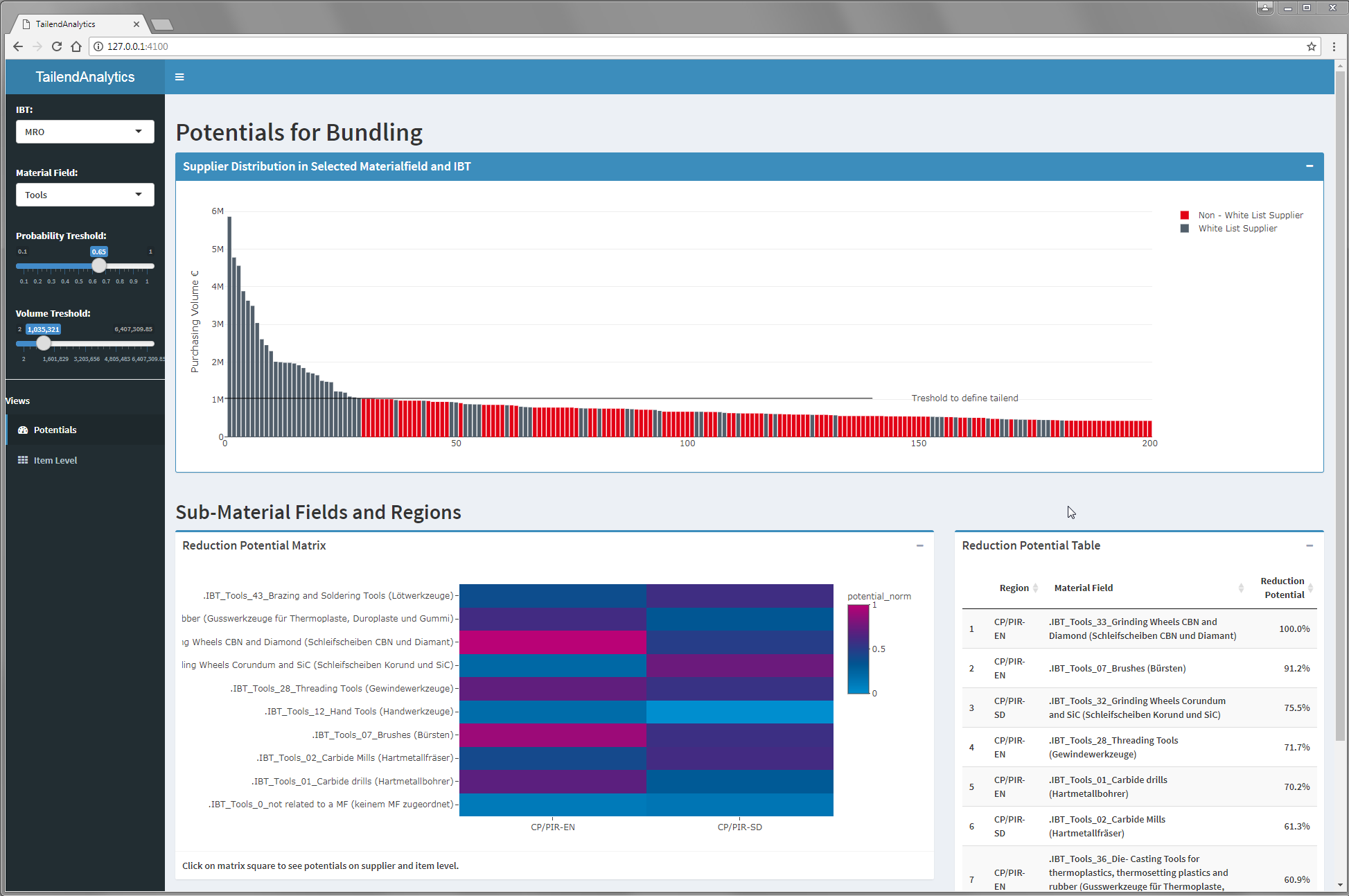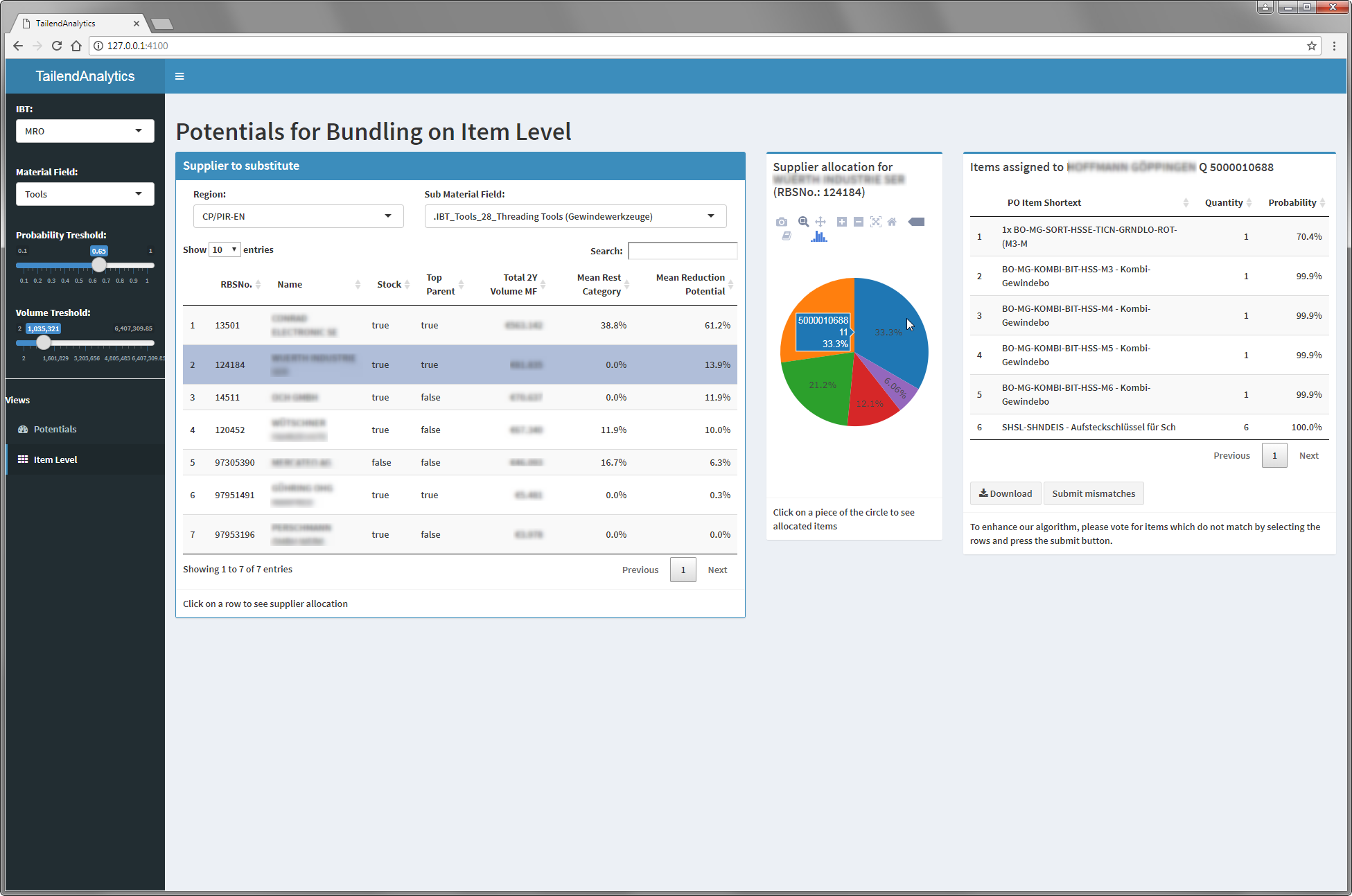
Self-Service Business Intelligence and Analytics
- Contact:
- Project Group:
- Funding:
Robert Bosch GmbH
- Partner:
Enables Users to Prepare, Analyze and Consume Data on their Own
Self-Service Business Intelligence and Analytics (SSBIA) is an upcoming approach and trend that enables casual business users to prepare and analyze data with easy-to-use Business Intelligence and Analytics (BIA) systems without being reliant on expert support or power users to perform their (complex) analytical tasks easier and faster than before.
This project has the objective to develop new concepts for Self-Service Business Intelligence and Analytics (SSBIA) in cooperation with the Robert Bosch GmbH, Corporate Sector Information Systems and Services and the Global Data Strategy department. The concepts will be created, implemented, and refined by going iteratively through several design iterations. In the focus of each cycle is the artefact, which can be mostly understood as a software-based prototype. The artefact will be created utilizing real-world data from the industry partner.
Problem Space
Business Intelligence and Analytics (BIA) refers to all “techniques, technologies, systems, practices, methodologies, and applications that analyze critical business data to help an enterprise better understand its business and market and make timely business decisions” (Chen et al., 2012, p. 1166). Logi (2017) illustrates that 66% of organizations use some sort of BIA tool to drive their business, whereas only 6% of organizations do not consider applying such systems. The size of the global BIA market is also expected to grow from $15.64 billion in 2016 to reach $29.48 billion by 2022 with a compound annual growth rate of 11.1% (BARC, 2019). Furthermore, as the provisioning of the right information to the right person at the right time is critical to remain competitive and represents a key concern of BIA (Bucher et al., 2009), new solutions such as data lakes – “a set of one or more data repositories that have been created to support data discovery, analytics, ad hoc investigations, and reporting” (Chessell et al., 2014; p. 1) – are still high in demand (e.g., Lennerholt et al., 2018).
A prominent example case refers to enable casual business users (referred in the following as casual users) to work with data by collaborating with skilled power or IT users (Alpar and Schulz, 2016). For instance, research suggests developing integrated collaboration platforms within the BIA landscape to support knowledge sharing and to solve complex issues with diverse user groups (e.g., Bani-Hani et al., 2018a; Passlick et al., 2017). Hereby, organizations face the challenge to support different user roles with diverse levels of expertise for various analytical demands ranging from information usage (e.g., access to reports) over information creation (e.g., creation of reports) towards information resources creation (e.g., harnessing of new data sources) (Alpar and Schulz, 2016). The common denominator to address these challenges refers to a branch of BIA technologies summarized under the term Self-Service Business Intelligence and Analytics (SSBIA). A major idea of SSBIA is that casual users will be able to prepare and analyze data with easy-to-use BIA systems without the need for expert support (Lennerholt et al., 2018). Well-known tools, such as KNIME (2019) and Tableau (2019), already offer self-service capabilities. KNIME represents a tool for interactive data analysis with the ability to implement numerous modules of Machine Learning (ML) methods (KNIME, 2019). Hereby, ML refers to the application of algorithms that improve with experience and learn from data (Mitchell, 1997). In turn, Tableau is an interactive visualization tool providing users the opportunity to link graphical user interfaces with drag and drop (Tableau, 2019). In general, SSBIA can empower causal users to create and share reports on their own from high volumes of diverse data without getting stuck into long running business requests with IT departments. Or as Eckerson (2009) has summed it up: “Users get exactly the reports they want, when they want (…)” (p. 2). In addition, SSBIA can help power users to perform their (complex) analytical tasks easier and faster than before (Alpar and Schulz, 2016).
Project Goals
The main objective of the project is to develop a system for SSBIA. Hereby, this system shall enable users to conduct analytical functions without the need for coding or setting up a compelling IT infrastructure upfront. Furthermore, as knowledge is required to apply analytical functions, the system shall give clear guidance based on expert knowledge to the user.
To define the overall project objectives, we identified the following research avenues in a systematic literature review (Michalczyk et al., 2020):
- Understand the Tade-Off between Top-Down and Bottom-Up SSBIA Capabilities
- Define a Method for Implementing SSBIA within Organizations
- Investigate Success Factors for Data Management and Data Governance
- Support Casual User’ Self-Reliance within the Analytical Investigation Process
In summary, design knowledge will be derived to extend existing Business Intelligence & Analytics Systems by making them “Self-Service”. In the research process, several artifacts will be created which serve as an instantiation making the research tangible.
Example Artefact: Tailend Analytics
This self-service artifact called "Tailend Analytics" was developed for supply-base reduction. The project was carried out jointly with the Global Indirect Purchasing Department of Robert Bosch GmbH. The objective was to enable buyers on any hierarchical level to understand and significantly reduce the number of suppliers in their responsible material area.

View 1 serves mainly Corporate Lead Buyer material fields and regions where they should start their optimization activities.

View 2 targets buyers on an operational level who want to inspect reallocations on item-level per supplier.
References
- Alpar, P., and Schulz, M. (2016). “Self-Service Business Intelligence,” Business and Information Systems Engineering (58:2), pp. 151–155. (DOI: 10.1007/s1259901604246).
- BARC (2019). “BI Trend Monitor - Business Application Research Center,” URL: https://barc-research.com/research/bi-trend-monitor/ (visit on 04/10/2019).
- Bani-Hani, I., Pareigis, J., Tona, O., and Carlsson, S. (2018a). “A holistic view of value generation process in a SSBI environment: a service dominant logic perspective,” Journal of Decision Systems (27:1), pp. 46–55. (DOI: 10.1080/12460125.2018.1468155).
- Bucher, T., Gericke, A., and Sigg, S. (2009). “Process-centric business intelligence,” Business Process Management Journal, (15:3), pp. 408-429.
- Chen, H., Chiang, R. H. L., and Storey, V. C. (2012). “Business intelligence and analytics: from big data to big impact,” MIS quarterly, (36:4), pp. 1165–1188. (DOI: 10.2307/41703503).
- Eckerson, W. (2009). Self-service BI. TDWI Checklist Report, TDWI Research Lennerholt, C., Van Laere, J., and Söderström, E. 2018. “Implementation Challenges of Self Service Business Intelligence: A Literature Review,” in Proceedings of the 51st Hawaii International Conference on System Sciences (HICSS), pp. 5055–5063 Logi (2017). Business Intelligence Adoption Report. URL: https://www.logianalytics.com/report/2017-state-analytics-adoption/ (visit on 04/20/2019).
- Michalczyk, Sven; Nadj, Mario; Azarfar, Darius; Maedche, Alexander; and Gröger, Christoph, "A State-of-the-art Overview and Future Research Avenues of Self-Service Business Intelligence and Analytics" (2020). ECIS 2020 Research Papers. 46. https://aisel.aisnet.org/ecis2020_rp/46
- Mitchell, T. (1997). Machine learning. McGraw-Hill Series in Computer Science.
- Passlick, J., Lebek, B., and Breitner, M. H. (2017). “A Self-Service Supporting Business Intelligence and Big Data Analytics Architecture,” In: Proceedings der 13. Internationalen Tagung Wirtschaftsinformatik (WI), (80:9), pp. 1126–1140. (DOI: 10.5120/13893-1840).

